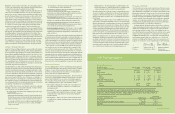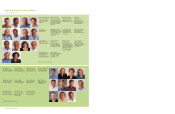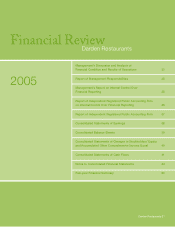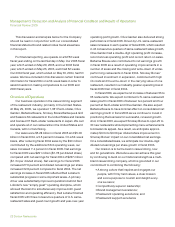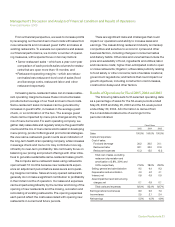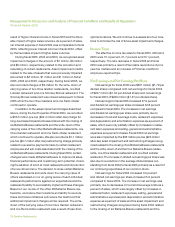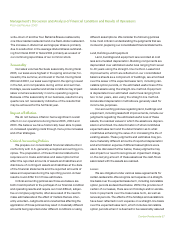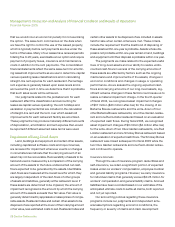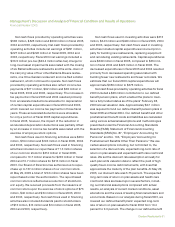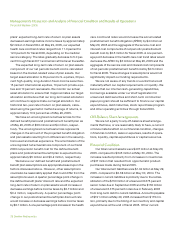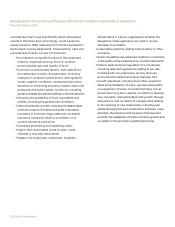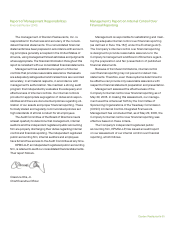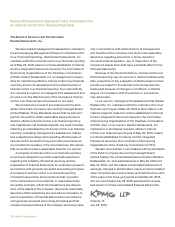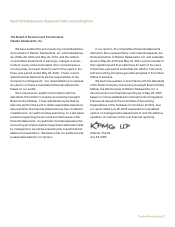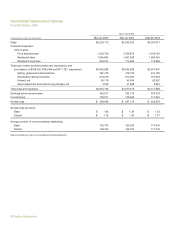Red Lobster 2005 Annual Report Download - page 20
Download and view the complete annual report
Please find page 20 of the 2005 Red Lobster annual report below. You can navigate through the pages in the report by either clicking on the pages listed below, or by using the keyword search tool below to find specific information within the annual report.Management’s Discussion and Analysis of Financial Condition and Results of Operations
Financial Review 2005
28 Darden Restaurants
that we would incur an economic penalty for not exercising
the option. The lease term commences on the date when
we have the right to control the use of the leased property,
which is typically before rent payments are due under the
terms of the lease. Many of our leases have renewal periods
totaling five to 20 years, exercisable at our option and require
payment of property taxes, insurance and maintenance
costs in addition to the rent payments. The consolidated
financial statements reflect the same lease term for amortiz-
ing leasehold improvements as we use to determine capital
versus operating lease classifications and in calculating
straight-line rent expense for each restaurant. Percentage
rent expense is generally based upon sales levels and is
accrued at the point in time we determine that it is probable
that such sales levels will be achieved.
Our judgments related to the probable term for each
restaurant affect the classification and accounting for
leases as capital versus operating, the rent holidays and
escalation in payments that are included in the calculation
of straight-line rent and the term over which leasehold
improvements for each restaurant facility are amortized.
These judgments may produce materially different amounts
of depreciation, amortization and rent expense than would
be reported if different assumed lease terms were used.
Impairment of Long-Lived Assets
Land, buildings and equipment and certain other assets,
including capitalized software costs and liquor licenses,
are reviewed for impairment whenever events or changes
in circumstances indicate that the carrying amount of an
asset may not be recoverable. Recoverability of assets to be
held and used is measured by a comparison of the carrying
amount of the assets to the future undiscounted net cash
flows expected to be generated by the assets. Identifiable
cash flows are measured at the lowest level for which they
are largely independent of the cash flows of other groups
of assets and liabilities, generally at the restaurant level. If
these assets are determined to be impaired, the amount of
impairment recognized is the amount by which the carrying
amount of the assets exceeds their fair value. Fair value is
generally determined by appraisals or sales prices of compa-
rable assets. Restaurant sites and certain other assets to be
disposed of are reported at the lower of their carrying amount
or fair value, less estimated costs to sell. Restaurant sites and
certain other assets to be disposed of are included in assets
held for sale when certain criteria are met. These criteria
include the requirement that the likelihood of disposing of
these assets within one year is probable. Assets whose dis-
posal is not probable within one year remain in land, buildings
and equipment until their disposal is probable within one year.
The judgments we make related to the expected useful
lives of long-lived assets and our ability to realize undis-
counted cash flows in excess of the carrying amounts of
these assets are affected by factors such as the ongoing
maintenance and improvements of the assets, changes in
economic conditions and changes in usage or operating
performance. As we assess the ongoing expected cash
flows and carrying amounts of our long-lived assets, sig-
nificant adverse changes in these factors could cause us to
realize a material impairment charge. In the fourth quarter
of fiscal 2004, we recognized asset impairment charges
of $37 million ($23 million after-tax) for the closing of six
Bahama Breeze restaurants and the write-down of four
other Bahama Breeze restaurants, one Olive Garden restau-
rant and one Red Lobster restaurant based on an evaluation
of expected cash flows. During fiscal 2005, we recognized
asset impairment charges of $6 million ($4 million after-tax)
for the write-down of two Olive Garden restaurants, one Red
Lobster restaurant and one Smokey Bones restaurant based
on an evaluation of expected cash flows. The Smokey Bones
restaurant was closed subsequent to fiscal 2005 while the
two Olive Garden restaurants and one Red Lobster restau-
rant continued to operate.
Insurance Accruals
Through the use of insurance program deductibles and
self-insurance, we retain a significant portion of expected
losses under our workers’ compensation, employee medical
and general liability programs. However, we carry insurance
for individual claims that generally exceed $0.25 million for
workers’ compensation and general liability claims. Accrued
liabilities have been recorded based on our estimates of the
anticipated ultimate costs to settle all claims, both reported
and not yet reported.
Our accounting policies regarding these insurance
programs include our judgments and independent actu-
arial assumptions regarding economic conditions, the
frequency or severity of claims and claim development


